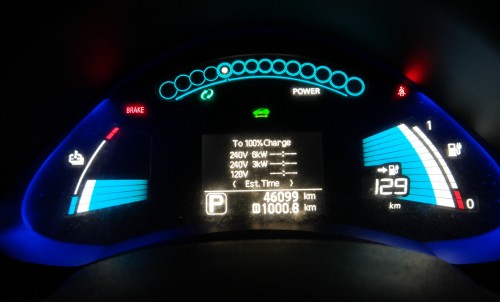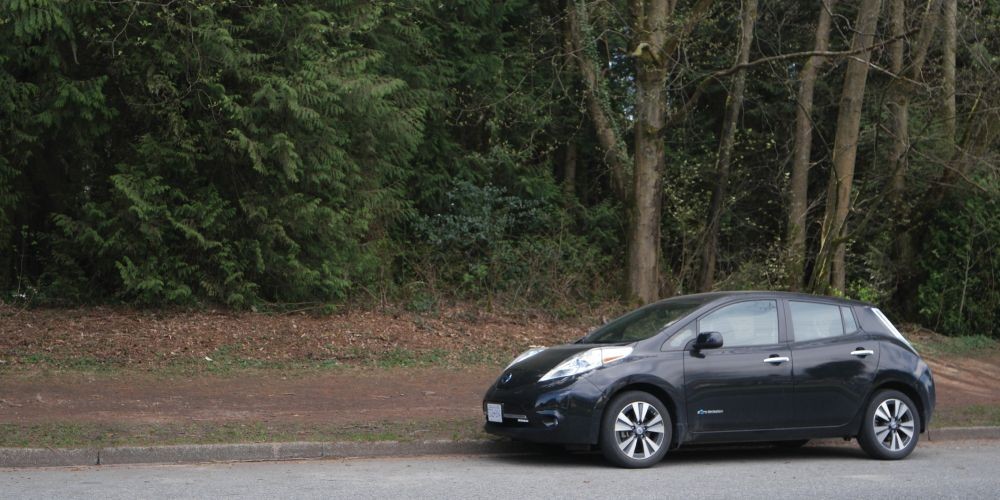After eight years of daily driving and real-world testing, my 2013 Nissan Leaf has proven itself to be a fantastic entry into the world of electric vehicles. While it’s not without its quirks, the positives of Leaf ownership are undeniable. Think minimal upkeep, zero emissions testing, no gas station visits, and significantly fewer parts to worry about. In my eight years and counting, maintenance has been limited to tire rotations and a single 12-volt battery replacement. The total damage? A surprisingly low $985 ($723.98 USD). Yes, you read that right.
Charging costs are another area where the Leaf shines. Many public parking areas offer free charging, sometimes bundled with parking fees that I’d be paying anyway. Even fast charging on the go rarely exceeds $7-$10. Over a year, you might spend anywhere from $200 to $800 on electricity, depending on your driving habits and access to free or cheaper charging options like overnight wall outlet charging, which can literally cost pennies. Despite concerns, home charging, often called “trickle charging”, doesn’t put a significant strain on your home’s electrical system.
Let’s dive into the realistic range, the brilliance of regenerative braking, charging specifics, reliability, where to find the best deals on Nissan Leafs, and even a secret tip for snagging one at a bargain price.
Nissan Leaf Range: Understanding the Models
| Model Year | Battery Capacity | Estimated Range (EPA) |
|---|---|---|
| 2010-2017 Nissan Leaf | 24 kWh | 84 miles / 135 km |
| 2018-2019 Nissan Leaf | 40 kWh | 158 miles / 252 km |
| 2020 Nissan Leaf | 62 kWh | 226 miles / 364 km |



The earlier Nissan Leaf models (2010-2017) are where range anxiety can become a factor compared to today’s EVs. Long distances aren’t their forte, but they excel as city commuters and local runabouts – which is how most vehicles are used day-to-day. Road trips are possible in these older Leafs, but plan for 20-30 minute fast-charging stops. Personally, I keep my “short road trips” under 75 miles in my older model.
From 2010 to 2017, the Leaf remained largely unchanged until a significant redesign in 2018. This refresh brought a more modern exterior and a welcome range increase to 158 miles / 252 km with a 40 kWh battery. The 2020 Nissan Leaf took another leap forward with a 62 kWh battery, boasting an EPA-estimated range of 226 miles / 364 km.
If your priority is ditching gasoline without breaking the bank on a brand-new EV, an older Nissan Leaf is a compelling option. Frequent road trippers might want to consider a newer Leaf or another EV with extended range. I’ve personally done trips like Seattle to Portland and Vancouver to Pemberton in my Leaf. Over 8 years, I’ve clocked 32,635 miles (52,521 kilometers), and the best part? Zero spent on gasoline. That feeling never gets old.
Charging Your Nissan Leaf: Simple and Straightforward
Charging a Nissan Leaf at a BC Hydro Fast Charger Station is a simple process across all model years. Just press the charge port button to open the door and plug in your cable. For added security, especially when charging in public, use the “Auto Lock” feature by pressing up on the button after plugging in. This locks the charger to your car, preventing removal until charging is complete. It’s also a considerate gesture to other EV drivers, signaling when the charger will be available. Fast charging at a public station typically takes 30-45 minutes to replenish a near-empty battery.
Nissan Leaf Charge Times (from Empty)
- 2010-2017 Nissan Leaf (24 kWh): 30 Minutes (Fast Charger) / 2 Hours (Level 2 Charger) / 8-10 Hours (Wall Outlet)
- 2018-2019 Nissan Leaf (40 kWh): 40 Minutes (Fast Charger) / 3-4 Hours (Level 2 Charger) / 8 Hours (Wall Outlet)
- 2020 Nissan Leaf (62 kWh): 1 Hour (Fast Charger) / 4-5 Hours (Level 2 Charger) / 11.5 Hours (Wall Outlet)
Nissan Leaf Regenerative Braking: Capturing Energy
Nissan even created a promotional video, “Nissan Leaf and the Volcano,” highlighting regenerative braking. It showed a driver in Hawaii using battery power to ascend a volcano and then recouping much of that energy on the descent. I had a similar experience driving up the Cascade Mountains from George, Washington. Reaching the summit, my range meter was critically low. However, on the downhill, I was amazed to gain back a significant charge, ending up with 89 miles (143 km) of range – far exceeding my expectations. Regenerative braking really works!
Nissan Leaf Reliability & Maintenance: Key Ownership Tips
The Nissan Leaf battery gauge and instrument cluster provides important information about the car’s status.
Battery Reliability: After 8+ years, my Nissan Leaf battery has shown minimal degradation, despite its age. While mileage is relatively low, the battery continues to perform well. The dashboard gauge still shows 10 out of 12 bars on the battery health meter (the vertical meter on the right). Nissan’s battery warranty covers 8 years or 100,000 miles, and significant battery degradation often doesn’t appear until 60,000-70,000 miles in older models. Even with frequent fast charging, my battery reliability has remained consistent.
Important Ownership Tip: This is crucial for all EVs: avoid leaving your car with a low battery charge for extended periods, especially in cold weather. I learned this the hard way. Leaving my Leaf for two weeks with only 26km of range was a mistake. Upon recharging, I noticed a battery health bar had disappeared. It makes sense in hindsight; batteries degrade faster when left at low charge levels for long durations. It’s analogous to leaving gasoline cars unused for extended periods, leading to fuel sediment and spark plug issues. EV batteries are designed for charge and discharge cycles; prolonged inactivity at low charge can accelerate degradation. This costly lesson hopefully benefits other EV owners. My Leaf’s battery is still excellent for a 10-year-old EV, but I believe I could have maintained 11 bars longer by avoiding low-charge storage.
Regarding Nissan Leaf maintenance, my only dealer visit was for a tire rotation, as they found no other issues. In 8 years, I’ve had zero mechanical problems. Now, after eight years, tire replacement or at least another rotation is on the horizon.
The only part I’ve replaced on my Nissan Leaf in 8 years is also found in gasoline cars… the 12-volt battery.
Jacob Haust
In 2020, the auxiliary 12-volt battery needed replacing. This battery powers everything except the main electric motor and is surprisingly necessary to start the vehicle. The engineering reason for this isn’t entirely clear to me. If anyone has insights, please share in the comments! Interestingly, this battery is partially charged by a small roof-mounted solar panel, meaning even auxiliary power in a Nissan Leaf has a touch of solar energy. The replacement cost? $130 CAD. Adding tire rotation ($50) and windshield washer fluid, and a new set of tires in 2023 for $800, my total 8-year maintenance cost is $985 ($723.98 USD).
Near-zero maintenance is a major perk of EVs. Compared to the complexity and potential failures of a combustion engine and the ongoing need for gasoline, EVs are significantly cheaper to own. With just one main moving motor component and no gasoline needed, EV maintenance is primarily tire inflation and washer fluid refills – especially with a reliable EV like the Nissan Leaf.
Nissan Leaf Winter Reliability: Surprisingly Capable
My 2013 Nissan Leaf came with all-season tires rated well for winter conditions. Beyond reduced winter range, Leafs perform surprisingly well in snow and ice. Counterintuitively, an EV’s weight is a winter driving advantage. The heavy battery pack provides enhanced grip, and its low placement lowers the center of gravity, improving overall handling.
Even in extreme Canadian cold, battery performance remains reasonable. Range does decrease by 10-20% in very cold temperatures, but this improves as the battery warms up. Using seat heaters instead of the cabin heater also conserves range. Parking and charging in a heated garage minimizes cold-weather range loss and improves charging efficiency. The front-wheel-drive Nissan Leaf, with its motor positioned over the front axle, offers excellent traction in snowy and icy conditions.
Used Nissan Leafs in the Pacific Northwest: A Smart Choice
A Nissan Leaf in Vancouver, British Columbia, Canada.
My most challenging trip was Seattle to Portland, requiring four charges each way and adding 4 hours to the round trip – not ideal in an older EV with 80 miles of range. Newer EVs, like the 2020 Nissan Leaf, make this trip easy with just one charge. That’s the progress of 8 years of EV development. For road trips, the 2020 Leaf is a much more relaxing and time-saving choice. When buying a used Leaf, check the battery health meter; 11 or 12 bars indicate excellent battery condition and long-term reliability.
For Pacific Northwest residents seeking an affordable EV, a used Nissan Leaf is an excellent option, especially in EV-friendly cities like Portland and Seattle. Both cities boast extensive charging infrastructure: over 200 public chargers in Portland and over 250 in Seattle (excluding Tesla Superchargers).
In large cities, used Nissan Leafs shine. Stop-and-go traffic allows for significant regenerative braking, sometimes even adding charge while driving in urban environments. Driving in downtown Seattle, I once gained 10 miles of range during a day of city driving – a testament to regenerative braking, a feature gasoline cars can’t match.
Buying a Used Nissan Leaf: Finding the Best Deals
Searching “Nissan dealership near me” will reveal a surprising number of used Leafs for sale. Nissan has produced over half a million Leafs globally, making used models readily available in the US and Canada. Prices can be as low as $9,000, with most averaging $14,000-$19,000 for low-mileage examples.
Here’s a secret for a great deal: check non-Nissan dealerships. Competitor dealerships often have less incentive to keep Leaf trade-ins on their lots and will price them lower to move them quickly, sometimes thousands less than Nissan dealerships.
2020 Nissan Leaf Price?
$32,000 – $42,000 USD
2010-2017 Used Nissan Leaf Price?
$5,000 – $29,000 USD
Consider the environmental impact: each Nissan Leaf on the road prevents 522+ gallons of gasoline per car per year (compared to a similar-sized gasoline car, based on a VW Golf). For every 100 Leafs, that’s 52,200+ gallons saved annually. With over 500,000 Leafs sold, that’s 261 million gallons of gasoline saved yearly!
My 8-year Nissan Leaf maintenance and charging costs are a fraction of what a gasoline car would consume in just months. EV ownership, especially a reliable model like the Nissan Leaf, offers significant savings in fuel and maintenance.
Overall, the Nissan Leaf is a remarkably reliable EV. My total 8-year maintenance was just $985 ($723.98 USD), and total charging costs have been minimal. My only real complaint about my 2013 Leaf (besides its older styling) is the 84-mile range. However, for city driving, it’s more than sufficient. The newer 2020 62kWh Leaf, with its 226-mile range, eliminates this concern for most drivers. If you need an affordable EV for city commuting, an older Nissan Leaf is one of the best budget-friendly options available.